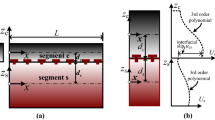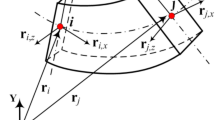Abstract
Analyzing static and dynamic problems including composite structures has been of high significance in research efforts and industrial applications. In this article, equivalent single layer approach is utilized for dynamic finite element procedures of 3D composite beam as the building block of numerous composite structures. In this model, both displacement and strain fields are decomposed into cross-sectional and longitudinal components, called consistent geometric decomposition theorem. Then, the model is discretized using finite element procedures. Two local coordinate systems and a global one are defined to decouple mechanical degrees of freedom. Furthermore, from the viewpoint of consistent geometric decomposition theorem, the transformation and element mass matrices for those systems are introduced here for the first time. The same decomposition idea can be used for developing element stiffness matrix. Finally, comprehensive validations are conducted for the theory against experimental and numerical results in two case studies and for various conditions.
Similar content being viewed by others
References
Madeira J F A, Araújo A L, Mota Soares C M, Mota Soares C A. Multiobjective optimization for vibration reduction in composite plate structures using constrained layer damping. Computers & Structures, 2017: 105810
Nie J, Wang J, Gou S, Zhu Y, Fan J. Technological development and engineering applications of novel steel-concrete composite structures. Frontiers of Structural and Civil Engineering, 2019, 13(1): 1–4
Budarapu P R, Sudhir Sastry Y B, Natarajan R. Design concepts of an aircraft wing: Composite and morphing airfoil with auxetic structures. Frontiers of Structural and Civil Engineering, 2016, 10(4): 394–408
Sakata S, Okuda K, Ikeda K. Stochastic analysis of laminated composite plate considering stochastic homogenization problem. Frontiers of Structural and Civil Engineering, 2015, 9(2): 141–153
Asadi H, Kiani Y, Aghdam M M, Shakeri M. Enhanced thermal buckling of laminated composite cylindrical shells with shape memory alloy. Journal of Composite Materials, 2016, 50(2): 243–256
Vo-Duy T, Ho-Huu V, Nguyen-Thoi T. Free vibration analysis of laminated FG-CNT reinforced composite beams using finite element method. Frontiers of Structural and Civil Engineering, 2018, 13(2): 324–336
Fattahi I, Mirdamadi H R. A novel 3D skeletal frame topology for energy harvesting systems. Microelectronics Journal, 2019, 83: 6–17
Rahmati M, Mirdamadi H R, Goli S. Divergence instability of pipes conveying fluid with uncertain flow velocity. Physica A, 2018, 491: 650–665
Fattahi I, Mirdamadi H R. Novel composite finite element model for piezoelectric energy harvesters based on 3D beam kinematics. Composite Structures, 2017, 179: 161–171
Fattahi I, Mirdamadi H R. A novel multimodal and multidirectional energy harvester by asymmetric 3D skeletal frame structures. Journal of the Brazilian Society of Mechanical Sciences and Engineering, 2020, 42(6): 274
Naeeni IP, Keshavarzi A, Fattahi I. Parametric study on the geometric and kinetic aspects of the slider-crank mechanism. Iranian Journal of Science and Technology, Transactions of Mechanical Engineering, 2019, 43(3): 405–417
Fattahi I, Mirdamadi H R. Electro-vibration modeling and response of 3D skeletal frame configuration for energy harvesters. Extreme Mechanics Letters, 2020: 100646
Rabczuk T, Ren H, Zhuang X. A nonlocal operator method for partial differential equations with application to electromagnetic waveguide problem. Computers, Materials & Continua, 2019, 59(1): 31–55
Anitescu C, Atroshchenko E, Alajlan N, Rabczuk T. Artificial neural network methods for the solution of second order boundary value problems. Computers, Materials & Continua, 2019, 59(1): 345–359
Guo H, Zhuang X, Rabczuk T. A deep collocation method for the bending analysis of Kirchhoff plate. Computers Materials & Continua., 2019, 59(2): 433–456
Hamdia K M, Ghasemi H, Zhuang X, Alajlan N, Rabczuk T. Sensitivity and uncertainty analysis for flexoelectric nanostructures. Computer Methods in Applied Mechanics and Engineering, 2018, 337: 95–109
Ghasemi H, Park H S, Rabczuk T. A multi-material level set-based topology optimization of flexoelectric composites. Computer Methods in Applied Mechanics and Engineering, 2018, 332: 47–62
Ghasemi H, Park H S, Rabczuk T. A level-set based IGA formulation for topology optimization of flexoelectric materials. Computer Methods in Applied Mechanics and Engineering, 2017, 313: 239–258
Nanthakumar S S, Lahmer T, Zhuang X, Zi G, Rabczuk T. Detection of material interfaces using a regularized level set method in piezoelectric structures. Inverse Problems in Science and Engineering, 2016, 24(1): 153–176
Grundberg S, Girhammar U A. A comparison of exact and approximate analyses of partially interacting composite beam-columns. In: The Fifteenth International Conference on Civil, Structural and Environmental Engineering Computing. Civil-Comp Press, 2015
Wang Q, Shi D, Liang Q. Free vibration analysis of axially loaded laminated composite beams with general boundary conditions by using a modified Fourier-Ritz approach. Journal of Composite Materials, 2016, 50(15): 2111–2135
Wenzel C, Vidal P, D’Ottavio M, Polit O. Coupling of heterogeneous kinematics and Finite Element approximations applied to composite beam structures. Composite Structures, 2014, 116: 177–192
Polit O, Gallimard L, Vidal P, D’Ottavio M, Giunta G, Belouettar S. An analysis of composite beams by means of hierarchical finite elements and a variables separation method. Computers & Structures, 2015, 158: 15–29
Karami M A, Inman D J. Analytical modeling and experimental verification of the vibrations of the zigzag micro structure for energy harvesting. Journal of Vibration and Acoustics, 2011, 133(1): 011002
Ananda Babu A, Edwin Sudhagar P, Rajamohan V. Dynamic characterization of thickness tapered laminated composite plates. Journal of Vibration and Control, 2016, 22(16): 3555–3575
Milazzo A. Refined equivalent single layer formulations and finite elements for smart laminates free vibrations. Composites. Part B, Engineering, 2014, 61: 238–253
Panda S, Kumar A. A design of active constrained layer damping treatment for vibration control of circular cylindrical shell structure. Journal of Vibration and Control, 2016, 24: 1077546316670071
Tornabene F. General higher-order layer-wise theory for free vibrations of doubly-curved laminated composite shells and panels. Mechanics of Advanced Materials and Structures, 2016, 23(9): 1046–1067
Reddy J N. Mechanics of Laminated Composite Plates: Theory and Analysis. CRC press, 1997
Weaver J R, Johnston P R. Structural Dynamics by Finite Elements. Englewood Cliffs, NJ: Prentice-Hall, 1987
Petyt M. Introduction to Finite Element Vibration Analysis. Cambridge University Press, 2010
Iannacci J, Sordo G. Up-scaled macro-device implementation of a MEMS wideband vibration piezoelectric energy harvester design concept. Microsystem Technologies, 2016, 22(7): 1639–1651
Muthalif A G, Nordin N D. Optimal piezoelectric beam shape for single and broadband vibration energy harvesting: Modeling, simulation and experimental results. Mechanical Systems and Signal Processing, 2015, 54–55: 417–426
Leo D J. Engineering Analysis of Smart Material Systems. Hoboken, NJ: John Wiley & Sons, 2007
Erturk A, Inman D J. Piezoelectric Energy Harvesting. John Wiley & Sons, 2011
Cook R D. Concepts and Applications of Finite Element Analysis. John Wiley & Sons, 2007
Zhang Y, Zhuang X. Cracking elements method for dynamic brittle fracture. Theoretical and Applied Fracture Mechanics, 2019, 102: 1–9
Zhang Y, Zhuang X. Cracking elements: A self-propagating strong discontinuity embedded approach for quasi-brittle fracture. Finite Elements in Analysis and Design, 2018, 144: 84–100
Zhuang X, Wang Q, Zhu H. Multiscale modelling of hydromechanical couplings in quasi-brittle materials. International Journal of Fracture, 2017, 204(1): 1–27
Ren H L, Zhuang X Y, Anitescu C, Rabczuk T. An explicit phase field method for brittle dynamic fracture. Computers & Structures, 2019, 217: 45–56
Author information
Authors and Affiliations
Corresponding author
Rights and permissions
About this article
Cite this article
Fattahi, I., Mirdamadi, H.R. & Abdollahi, H. Application of consistent geometric decomposition theorem to dynamic finite element of 3D composite beam based on experimental and numerical analyses. Front. Struct. Civ. Eng. 14, 675–689 (2020). https://doi.org/10.1007/s11709-020-0625-4
Received:
Accepted:
Published:
Issue Date:
DOI: https://doi.org/10.1007/s11709-020-0625-4




